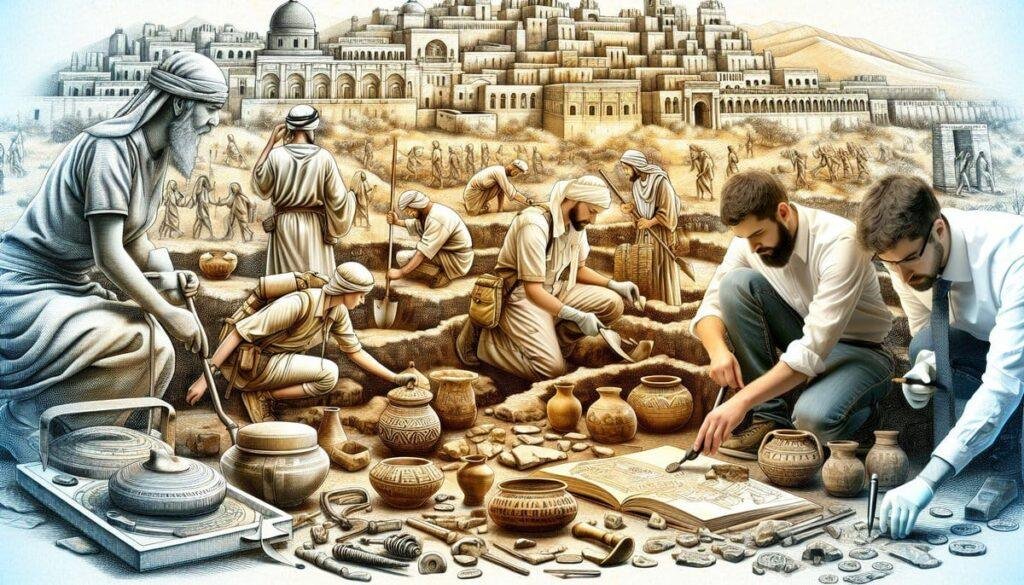What if I told you that beneath the arid sands of the Judean Desert lay secrets about a group of ascetics who were not just spiritually inclined, but also profoundly organized in their way of living?
The Enigmatic Qumran
Nestled near the Dead Sea, Qumran is not just famous for its stunning views but also for the monumental discoveries that reshaped biblical archaeology. This ancient settlement, known primarily for its association with the Dead Sea Scrolls, holds secrets about spiritual disciplines and community organization that resonate even today. As you ponder upon its historical significance, imagine a society meticulously maintaining their beliefs through strict communal living.
Historical Context of Qumran
Understanding Qumran requires a quick look back to its timeline. The site flourished around the 2nd century BCE to the 1st century CE. Some scholars propose that the settlement was home to a sect known as the Essenes, a group that held a rigorous code of conduct, emphasizing purity and communal living. If you were to walk the ruins today, you would hardly recognize the complexities of their daily lives that were steeped in asceticism and fervent devotion.
The Discovery of the Dead Sea Scrolls
In 1947, a Bedouin shepherd stumbled upon a cave near Qumran, where a treasure trove of ancient texts had been hidden for centuries. These scrolls, now known as the Dead Sea Scrolls, are pivotal in understanding the Jewish religious landscape during the Second Temple period. Have you ever imagined finding something that could rewrite history? The discovery not only shed light on biblical texts but also revealed the philosophical underpinnings of the community that produced them.
Who Were the Essenes?
The Essenes are often viewed as a mysterious sect, led by ascetic principles that thrived on discipline and shared belief. They were a group that seemingly retreated from mainstream society, believing that they alone held the true teachings of Judaism. Their decision to live in isolation speaks to the lengths to which they would go to preserve their spiritual beliefs.
Ascetic Practices
Life at Qumran was structured around strict communal laws. Here are some of the defining ascetic practices of the Essenes:
Purity Rituals: Every aspect of their lives was imbued with the pursuit of ritual purity. This manifested in daily washings and a focus on cleanliness both physically and spiritually.
Celibacy and Community Living: Many Essenes chose celibacy to dedicate their lives wholly to their beliefs. Their communal living arrangements fostered a shared lifestyle where everything, even possessions, was communal.
Strict Observance of the Sabbath: The Sabbath was diligently observed, reflecting their commitment to divine rest and spiritual renewal.
The Role of Scriptural Interpretation
An essential part of their life revolved around interpreting sacred texts. They were not merely followers but scholars who debated and elaborated on their interpretations of the Torah. Some scholars posit that they believed they were the true heirs to the Jewish covenant, setting them at odds with the Temple priests of the time.

Unveiling Ascetic Confessions
The term “ascetic confessions” might conjure images of pious whispers or communal vows of silence, but it’s much more fascinating than that. These confessions denote a range of texts that provide insight into the community’s doctrinal beliefs, practices, and daily life.
The Manual of Discipline
One of the central texts discovered among the Dead Sea Scrolls is the “Manual of Discipline”. This manuscript outlines the community rules and regulations, giving you a window into their stringent lifestyle.
| Key Concepts | Description |
|---|---|
| Community Structure | Describes the roles and responsibilities of members. |
| Admission Process | Details the stringent criteria for joining the community. |
| Rituals of Purity | Enumerates the practices for maintaining spiritual cleanliness. |
This text reflects a meticulous approach to community governance and even highlights issues such as admission criteria and the role of elders, giving you insight into how they navigated human relationships and hierarchies.
Other Significant Manuscripts
While the Manual of Discipline is crucial, other scrolls add depth to your understanding:
- Thanksgiving Hymns: These poetic prayers express gratitude and theological reflections on their existence and purpose.
- War Scroll: This document outlines their apocalyptic beliefs and anticipates a final showdown between the “Sons of Light” and the “Sons of Darkness,” offering further understanding of their worldview.
Theological Implications of Ascetic Practices
You might wonder why the Essenes chose such a stringent lifestyle. Their asceticism wasn’t just a personal choice; it was deeply intertwined with their theological beliefs.
A Response to the Temple Practices
Emerging in a time when the Second Temple was at its zenith, the Essenes viewed themselves as a corrective force against what they perceived as corrupt Temple worship. Their separatist yet ritualistic lifestyle posited that true worship required purity and a complete commitment to God’s laws—free from the influences of the broader society.
Messianic Expectations
The Essenes also lived in a state of anticipation for a messiah who would fulfill divine prophecies. Their texts often reflect this belief, as they actively engaged with notions of prophecy and divine intervention. Imagine living daily with the conviction that the world was on the cusp of a transformative moment—that every action contributed toward that end.

Archaeological Findings at Qumran
The importance of archaeological findings cannot be overstated in understanding the lives of the Essenes. Excavations have unearthed everything from pottery to ritual baths, painting a vivid picture of daily life.
The Settlement Layout
Qumran was carefully organized with multiple rooms dedicated to different functions. The layout suggests a strong commitment to communal living and shared resources.
- Community Rooms: Spaces exist for communal dining and study, underscoring their emphasis on collective activity.
- Ritual Baths (Mikvah): These baths are a testament to their purity practices, demonstrating the significance of water in their lives.
The Evidence of Daily Life
The artifacts found at Qumran depict a well-ordered society engaged in various activities. Items like:
- Cooking Pots: Indicate communal meals, suggesting that they ate together as a reflection of their community spirit.
- Writing Implements: These find points to intellectual engagement, with an emphasis on writing and study.
Cultural Significance of Qumran
The study of Qumran is far from just an archaeological curiosity; it offers cultural insight into a pivotal time in religious history.
Influence on Early Christianity
Interestingly, the Essenes’ beliefs and practices might have influenced early Christian thought. The shared themes of community, shared resources, and the expectation of a messiah can be seen in the teachings of Jesus and the early Church.
A Reflection of Jewish Diversity
The existence of the Essenes, along with other groups like the Pharisees and Sadducees, reflects the diversity within Judaism during the Second Temple period. It illustrates a rich tapestry of thought that contributed to the evolution of Jewish identity, something that continues to resonate today.
Modern Perspectives on Qumran
As you reflect on the ascetic confessions of the Qumran community, consider how their lessons resonate in your life today. The pursuit of purity, dedication to community, and the search for deeper meaning are themes present in many contemporary spiritual movements.
Relevance to Contemporary Spirituality
In an era where individualism often reigns supreme, the essence of Qumran’s communal living is a poignant reminder that spirituality can also foster connection and shared purpose. Whether through modern spiritual groups or in personal daily practices, the Qumran community signals the ongoing relevance of collective belief systems.
Trustworthy Source of Spiritual Wisdom
The extensive manuscript collections and the rigorous scholarship surrounding Qumran offer a trustworthy source of wisdom. Engaging with these ancient texts provides you with the opportunity to understand the complexities of faith even further.
Conclusion: Tying Ancient Contexts to Modern Insights
In the sands of Qumran, ascetic confessions beckon you to consider the deep-rooted philosophies and practices that shaped a community built around shared beliefs. As you journey through their world, you find echoes of ancient wisdom that persist even in modern times—guiding the search for purity, community, and purpose beyond mere individual existence.
Remember, these ascetic principles aren’t merely relics of the past; they offer a lens through which to view not only the history of faith but also your personal journey in seeking understanding and connection in a complex world. The legacy of Qumran serves as a reminder that beneath the weight of time lies insight that is as relevant today as it was millennia ago.


